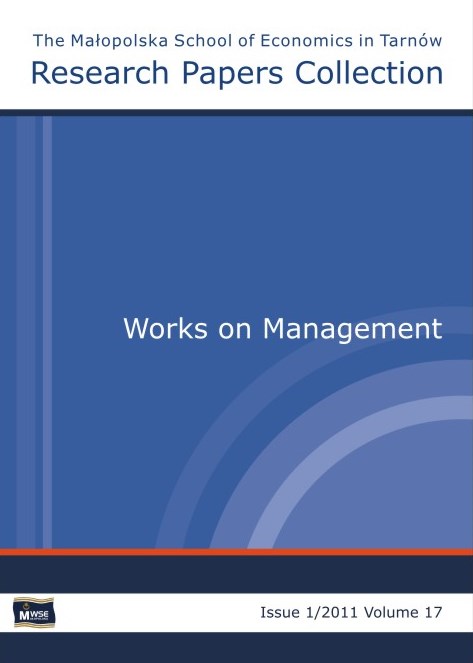Abstract
Building image of a company accepted by the environment is a long and expensive process which requires time and consistence as well as work of many persons, but comparison of expenditures and benefits justifies undertaking such actions. The actual image of the corporation produced in the consciousness of the recipients highly deviates from the desired, perfect characteristics of corporate identity. The degree of consistence of image and identity depends on the effectiveness of the image communication process. Building the image of the company cannot be based on the image alone (logo, graphics, forms, lettering, colours, interior design style). Other factors have high or possibly the most important significance in the process of developing the positive image of the company. Supplementing the image of the company with communication and behaviour gives the possibility of producing the appropriate image in the client’s reception, as the actual image is developed by the client only during direct confrontation with the product, the service or the employees of the company. Only these organisations may grow which will know the needs of the market and which can adjust their resources to them and leave the competition behind along the way. Only positive image may be the source of competitive edge. Achieving competitive edge related to having positive image may be gained with: strengthening it (if its potential was not used so far) or building a new positive image from the scratch (if the previous did not bring about the planned results).
The financial consequence of active building of the company image may be in the form of adding value to it by the investors, which is expressed in creating positive goodwill. It constitutes, on the one hand, specific resources of the company (intangibles), and on the other hand it brings about new equity to the companies and business entities. Success is achieved when the future is better planned, permanent strategic choices are made, and conducive circumstances help overcome competitors. However, it is related to the risk of failure.
References
Altkorn J. 1999. Wizualizacja firmy. Kraków: Instytut Marketingu.
View in Google Scholar
Gołębiowski T., Dudzik T.M., Lewandowska M., Witek-Hajduk M. 2008. Modele biznesu polskich przedsiębiorstw. Warszawa: Szkoła Głowna Handlowa. ISBN 978-83-7378-347-8.
View in Google Scholar
Kaplan R.S., Norton D.P. 2010. Wdrażanie strategii dla osiągnięcia przewagi konkurencyjnej. Transl. by G. Łuczkiewicz. Warszawa: Wydawnictwo Naukowe PWN. ISBN 978-83-01-16124-8.
View in Google Scholar
Kotler Ph. 2005. Marketing. Transl. by R. Bartołd et al. Poznań: Rebis. ISBN 83-7301-532-9.
View in Google Scholar
Kozioł L. 2010. “Entrepreneur’s business models”. The Małopolska School of Economics in Tarnów Research Papers Collection, iss. 2 (16).
View in Google Scholar
Morgan M., Levitt R.E., Malek W. 2010. Skuteczne wdrażanie strategii. Transl. by A. Trzcińska. Warszawa: Wydawnictwo Naukowe PWN. ISBN: 978-83-01-16187-3.
View in Google Scholar
Nogalski B., Rutka R. 2007. “Kluczowe kwestie współczesnego rozwoju nauk o zarządzaniu w Polsce”. In: Współczesne kierunki rozwoju nauk o zarządzaniu: Księga jubileuszowa z okazji 50-lecia pracy naukowej i dydaktycznej Profesora Jerzego Rokity. Ed. K. Jędralska. Katowice: Górnośląska Wyższa Szkoła Handlowa im. Wojciecha Korfantego.
View in Google Scholar
Pierścionek Z. 2007. Strategie konkurencji i rozwoju przedsiębiorstwa. Warszawa: Wydawnictwo Naukowe PWN. ISBN 978-83-01-14085-4.
View in Google Scholar
Porter M. 2010. Strategia konkurencji. Metody analizy sektorów i konkurentów. Transl. by A. Ehrlich. Warszawa: Państwowe Wydawnictwo Ekonomiczne. ISBN 978-83-6219578-7.
View in Google Scholar
Program dla elektroenergetyki. 27 March 2006. Warszawa: Ministerstwo Gospodarki.
View in Google Scholar
Trout J., Rivkin S. 2011. Repozycjonowanie: Marketing w erze konkurencji, zmian i kryzysu. Transl. by B. Solecki. Warszawa: Polskie Wydawnictwo Ekonomiczne. ISBN: 978-83-208-1933-5.
View in Google Scholar
Urbanek G. 2000. “Marka a przewaga konkurencyjna przedsiębiorstwa”. Marketing i Rynek, no. 8–9.
View in Google Scholar
© Copyright by Małopolska School of Economics in Tarnów. The articles are available under the Creative Commons Attribution NonCommercial-NoDerivatives 4.0 International License


